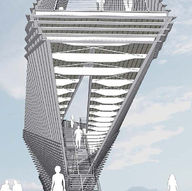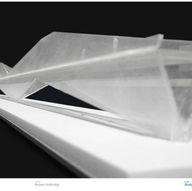
Location : Beijiao, Guangdong, China
Type: Architecture Design / Bridge Design
Design Team: Ruggero Baldasso con Tim Weng / Tony Zhang / Wang Qaing
Design Time: 2007
项目地点:北滘,广东,中国
项目类型:建筑设计 / 桥梁设计
设计团队: Ruggero Baldasso con Tim Weng / Tony Zhang / Wang Qaing
设计时间:2007
▼
The skin becomes the structure of the bridge and substitutes what ordinarily pillars or metal wire would do, the intertwining double reverse spirals are its DNA-like geometrical framework, the sequence of squares unwrap it into the various settings its crossing and connecting, the shadow of the ventilated roofs lower the temperature at daytime along the suspended pathway.
在这个项目里,外皮变成了代替的桥梁的结构,并且替换了通常的支柱或金属网格的作用,相互交织的双螺旋结构就是桥的如DNA一样的几何框架,在方形序列解构之下重组为多样化的交织连接体系,通风屋顶的阴影降低了白天沿桥通过时的日晒。

The structural metal skin is designed both to shed people from direct sub-tropical sun and to provide the bridge an iconic value for Beijiao.
金属结构表皮既可作为为人们遮挡亚热带太阳辐射热,也可以为北滘提供一个标志性建筑。
This skinned bridge has a tri-dimensional body and not just a flat walkway. Pedestrians enter it through its belly and both ends are viewpoint heads gazing at the urban environments. Its structural sun-shades look like snake skin, its wavy shape and its size make it look like a double-headed dragon!
这个表皮化的人行桥并不是简单的一个平面化的步行廊,而是一个具有三维空间的形状。人们通过桥的腹部进入桥体,两端的视觉焦点聚集在城市环境上。它的结构化的百叶看起来就像是蛇的皮肤,其波动的形态和体量也使其看起来像是一条双头龙!



The bridge becomes a gate to modern Beijiao. Cars get across it and a pedestrians use it as a link between the old and the new urban centers.
人行桥变成了通向现代北滘的一个大门。汽车通过的时候和行人们使用的时候它就像是一个连接了旧中心和新城市的枢纽。
The shape of the bridge develops from the need for a sheltered walkway hovering above the ground level. The original round section of an armored hosepipe crossed inside by the walkway folds at first into a square touching the ground with one of its corners, and then the opposite corner is pulled upwards to make the section become a diamond with its shortest diagonal parallel to the ground. The light wooden floor provides the structure the needed rigidity.
桥的形态是从漂浮在地面上的受遮蔽的行人道这样一个需求发展而来的。原先的环形剖面是一个带壳的软管穿越期间,人行道折叠着变成方形并通过一个角连接地面,对角拉升提高并把剖面变成一个钻石型,最短边斜向互为平行地连接地面。轻木的地面材料提供了结构所需的刚度。





The scale of the site and the length of the bridge are making it a project about a line suspended above the horizon. The thickness of the bridge becomes geometrically almost irrelevant when compared to its length. On a large scale the line has no thickness, therefore the project will be about its folding; on a small scale the initial line turns into several ones and their folding become the structure-facade.
基地的规模和桥的长度使这个桥变成一根悬浮在地平线上的水平线。桥的厚度与它的长度相比而已显得无关紧要。在一个大尺度范围上说,线是没有厚度的,因此这个项目是关于单线的折;而在一个小尺度范围上说,最初的线变成了多重的,并且它们的互相折叠而变成了结构的立。





















